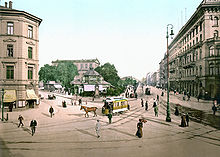Pointed Roofs
 Am Kröpcke, the centre of the city of Hanover, in 1895. Richardson was there in 1891. | |
| Author | Dorothy Richardson |
|---|---|
| Language | English |
| Genre | Novel |
| Publisher | Duckworth |
Publication date | 1915 |
| Publication place | England |
| Followed by | Backwater |
Pointed Roofs, published in 1915, is the first work (she called it a "chapter") in Dorothy Richardson's (1873 – 1957) series of 13 semi-autobiographical novels titled Pilgrimage,[1] and the first complete stream of consciousness novel published in English. The novelist May Sinclair (1863 – 1946) first applied the term "stream of consciousness" In a review of Pointed Roofs (The Egoist April 1918).
Miriam Henderson, the central character in Pilgrimage, is based on author's own life between 1891 and 1915.[2] In Pointed Roofs, seventeen years old Miriam Henderson has her first adventure as an adult teaching English at a finishing school in Hanover, Germany. Richardson herself had left home in 1891, at seventeen, to take up the post of student teacher at a school in Hanover, because of her father's financial problems.[3]
Bibliography
- Pointed Roofs, London: Duckworth, 1915. Online text at [2]
References
- ^ Joanne Winning (2000). The Pilgrimage of Dorothy Richardson. Univ of Wisconsin Press. ISBN 978-0-299-17034-9.
- ^ Goria G. Fromm, ed., Windows on Modernism: Selected Letters of Dorothy Richardson, ed. Athens, Georgia, U. of Georgia Press, 1995, xviii–xix.
- ^ Rebecca Bowler, "Dorothy M Richardson deserves the recognition she is finally receiving", The Guardian, 15 May 2015 [1]
